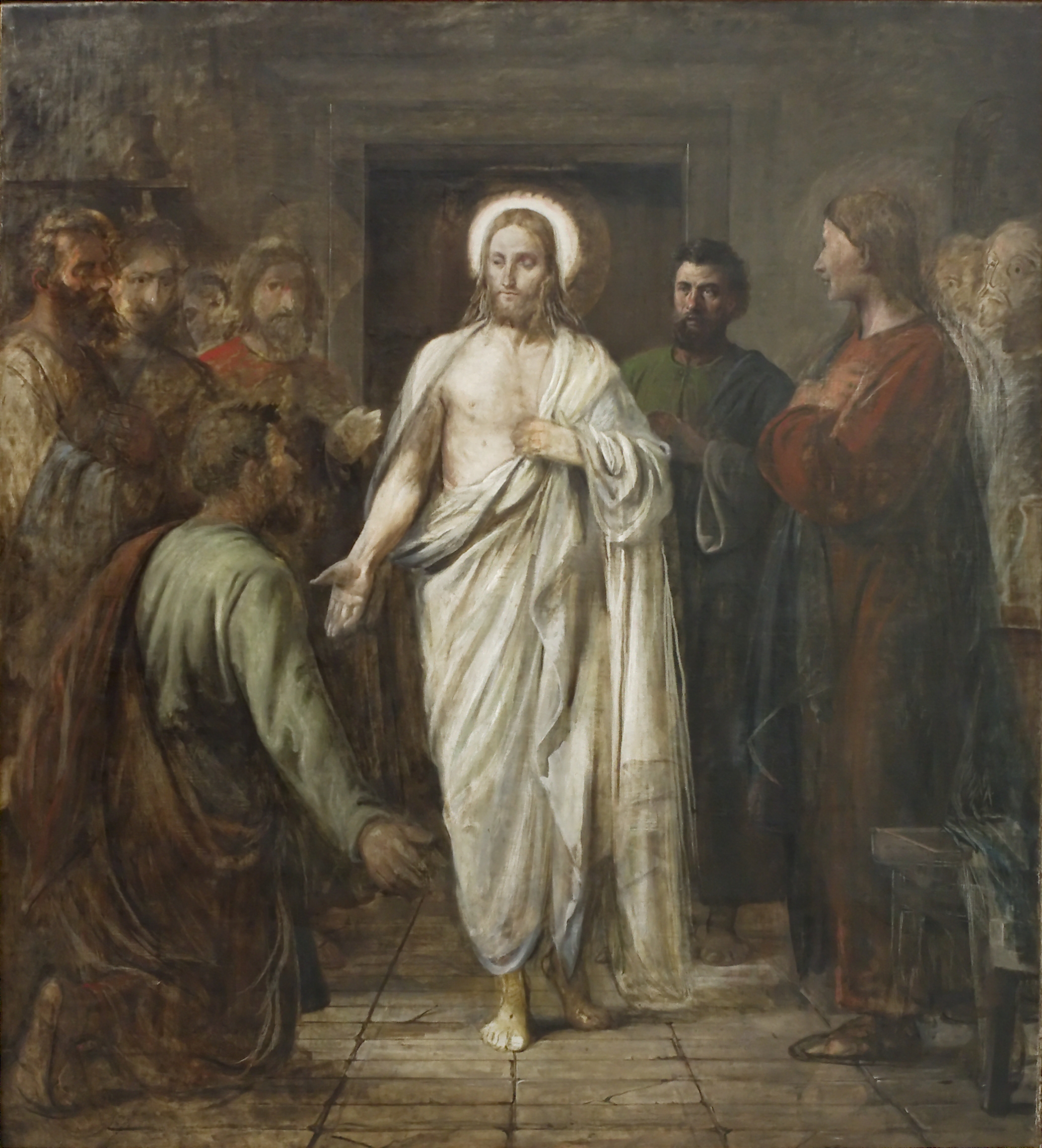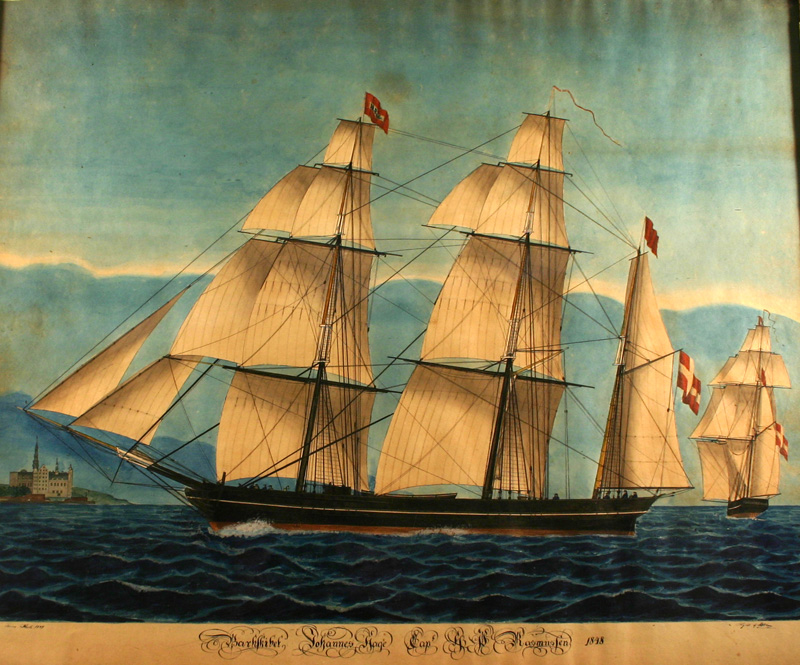|
Christopher Friedenreich Hage (1759–1849)
Christopher Friedenreich Hage (19 July 1759 – 15 August 1849), was a Danish merchant on the island of Møn. He was the father of Alfred Hage, Hother Hage, Johannes Dam Hage and Bolette Hage. Early life and career Hage was born in 1759, in Stege on Møn the son of Johannes Jensen Hage (1714-1791) and Bodil Margrethe Friedenreich (1729-1805). His family had been merchants on the island for many generations and he followed in his father's footsteps. Having acquired significant wealth, he built the Hage House in Stege in 1796. He was the younger brother of Jens Friedenreich Hage. Family He married Arnette Christiane née Just. They had 10 children. His sons Alfred Hage and Christopher Theodor Friedenreich Hage (1819-1872) became successful merchants. His son Johannes Dam Hage contributed regularly to the newspaper Fædrelandet and was one of the leading initiators of the transformation of Denmark to a constitutional monarchy, as was his son Hother Hage. His daughte ... [...More Info...] [...Related Items...] OR: [Wikipedia] [Google] [Baidu] |
Wilhelm Marstrand
Nicolai Wilhelm Marstrand (24 December 1810 – 25 March 1873), painter and illustrator, was born in Copenhagen, Denmark, to Nicolai Jacob Marstrand, instrument maker and inventor, and Petra Othilia Smith. Marstrand is one of the most renowned artists belonging to the Golden Age of Danish Painting. Early development and academy training Marstrand studied at Copenhagen's Metropolitan School ('' Metropolitanskolen''), but had little interest in books, and left around 16 years of age. Christoffer Wilhelm Eckersberg, painter and professor at the Royal Danish Academy of Art () in Copenhagen, was a close friend of Wilhelm's father, and it was to all appearance Eckersberg who recommended an artistic career for young Wilhelm. Wilhelm had already shown artistic talent, tackling difficult subjects such as group scenes with many figures and complicated composition. At 16 years of age Marstrand thus began his studies at the Academy under Eckersberg, attending the school from 1826 to 18 ... [...More Info...] [...Related Items...] OR: [Wikipedia] [Google] [Baidu] |
Dansk Biografisk Leksikon
''Dansk Biografisk Leksikon'' (usually abbreviated DBL; title of first edition written ''Dansk biografisk Lexikon'') is a Danish biographical dictionary that has been published in three editions. The first edition, ''Dansk biografisk Lexikon, tillige omfattende Norge for tidsrummet 1537–1814'' (''"...including Norway for the period 1537–1814"'') was published in nineteen volumes 1887–1905 under the editorship of the historian Carl Frederik Bricka. The first edition, which is in the public domain The public domain (PD) consists of all the creative work to which no Exclusive exclusive intellectual property rights apply. Those rights may have expired, been forfeited, expressly Waiver, waived, or may be inapplicable. Because no one holds ... is available online at Projekt Runeberg. Later editions were published 1933–1934 (27 volumes) and 1979–1984 (16 volumes). While some of the biographies from the previous editions have been updated in the third edition, many othe ... [...More Info...] [...Related Items...] OR: [Wikipedia] [Google] [Baidu] |
Hage Family
Hage (East Frisian language, East Frisian: ''Haag'') is a small East Frisian town (''Flecken'') in Lower Saxony, Germany. Located in the Aurich (district), district of Aurich close to the North Sea, approximately 5 km east of Norden, Lower Saxony, Norden, Hage has a population of 6,424 as of 31 December 2022. Hage is also the seat of the ''Samtgemeinde'' ("collective municipality") Hage (Samtgemeinde), Hage. To the municipality of Hage belong the villages (''Ortsteile'') of Berum, Hage, Berum, Blandorf, Hagerwilde, and Wichte. The former is the site of Berum Castle, which played an important role in History of East Frisia, East Frisian history. Gallery Burg Berum-msu-2021-210-4738.jpg, Burg Berum Hager Mühle ohne Fluegel.jpg, Windmill Bahnhof Hage (Ostfriesland).jpg, Hage railway station Notable people *Johan Rudolph Deiman (1743–1808), physician and chemist *Hans-Werner Fischer-Elfert (born 1954), Egyptologist *Rudolf Ströbinger (1931–2005), journalist and write ... [...More Info...] [...Related Items...] OR: [Wikipedia] [Google] [Baidu] |
People From Møn
The term "the people" refers to the public or Common people, common mass of people of a polity. As such it is a concept of human rights law, international law as well as constitutional law, particularly used for claims of popular sovereignty. In contrast, a people is any plurality of Person, persons considered as a whole. Used in politics and law, the term "a people" refers to the collective or community of an ethnic group or nation. Concepts Legal Chapter One, Article One of the Charter of the United Nations states that "peoples" have the right to self-determination. Though the mere status as peoples and the right to self-determination, as for example in the case of Declaration on the Rights of Indigenous Peoples, Indigenous peoples (''peoples'', as in all groups of indigenous people, not merely all indigenous persons as in ''indigenous people''), does not automatically provide for independence, independent sovereignty and therefore secession. Indeed, judge Ivor Jennings i ... [...More Info...] [...Related Items...] OR: [Wikipedia] [Google] [Baidu] |
18th-century Danish Businesspeople
The 18th century lasted from 1 January 1701 (represented by the Roman numerals MDCCI) to 31 December 1800 (MDCCC). During the 18th century, elements of Enlightenment thinking culminated in the Atlantic Revolutions. Revolutions began to challenge the legitimacy of monarchical and aristocratic power structures. The Industrial Revolution began mid-century, leading to radical changes in human society and the environment. The European colonization of the Americas and other parts of the world intensified and associated mass migrations of people grew in size as part of the Age of Sail. During the century, slave trading expanded across the shores of the Atlantic Ocean, while declining in Russia and China. Western historians have occasionally defined the 18th century otherwise for the purposes of their work. For example, the "short" 18th century may be defined as 1715–1789, denoting the period of time between the death of Louis XIV of France and the start of the French Revolution, ... [...More Info...] [...Related Items...] OR: [Wikipedia] [Google] [Baidu] |
Danish Merchants
Danish may refer to: * Something of, from, or related to the country of Denmark People * A Danish person, also called a "Dane", can be a national or citizen of Denmark (see Demographics of Denmark) * Culture of Denmark * Danish people or Danes, people with a Danish ancestral or ethnic identity * A member of the Danes, a Germanic tribe * Danish (name), a male given name and surname Language * Danish language, a North Germanic language used mostly in Denmark and Northern Germany * Danish tongue or Old Norse, the parent language of all North Germanic languages Food * Danish cuisine * Danish pastry, often simply called a "Danish" See also * Dane (other) * * Gdańsk * List of Danes * Languages of Denmark The Kingdom of Denmark has only one official language, Danish, the national language of the Danish people, but there are several minority languages spoken, namely Faroese, German, and Greenlandic. A large majority (about 86%) of Danes also ... {{disambigu ... [...More Info...] [...Related Items...] OR: [Wikipedia] [Google] [Baidu] |
Hans Puggaard
Hans Puggaard (3 September 1788 - 8 April 1866) was a Danish merchant and shipowner who founded H. Puggaard & Co. in 1813. The company became a leading wholesaler of grain and was also active in the market for import of goods such as coffee and especially sugar. Puggaard was also an important philanthropist dedicating much of his fortune to social causes. Puggaard's wife, Bolette Puggaard née Hage, a daughter of Christopher Friedenreich Hage, was a painter. The couple supported many of the artists of the Danish Golden Age. Their daughter married Orla Lehmann. Early life and education Puggard was born in Copenhagen in poor conditions. His parents were Thomas Puggaard (1748-1818) and Cathrine Marie Puggaard née Svane (1754-1814). His father was assistant cantor at the Church of Holmen and owner of the punch bar at the Royal Theatre on Kongens Nytorv. He was initially not sent to school but had to assist in his father's punch bar, but later attended Det von Westenske Institut ... [...More Info...] [...Related Items...] OR: [Wikipedia] [Google] [Baidu] |
Jens Friedenreich Hage
Jens Friedenreich Hage (6 October 1752 - 17 June 1831) was a Denmark, Danish merchant and landowner. Early life Hage was born on 6 October 1752 in Stege, Denmark, Stege on the island of Møn, the eldest child of Johannes Jensen Hage and Bolette Margrethe Friedenreich. The Hage family was of Dutch origins and had counted merchants at least since the 17th century. He was the elder brother of Christopher Friedenreich Hage (1759–1849), Christopher Friedenreich Hage. Career On 11 July 1765, Hage passed his exams as a helmsman. In 1777 he moved to the Danish West Indies where he made a fortune as a merchant and plantation owner. He was the owner of the plantation Frederiks Haab, U.S. Virgin Islands, Frederikshaab on Saint Croix, St, Croix. He also purchased the Clairfield estate at Pennsylvania, In 1790, he was back in Stege. In the late 1890s, he settled as a merchant in Copenhagen. He traded under the name J. F. Hage & Co. in spite of the fact that he had no partners. In 1800, he ... [...More Info...] [...Related Items...] OR: [Wikipedia] [Google] [Baidu] |

